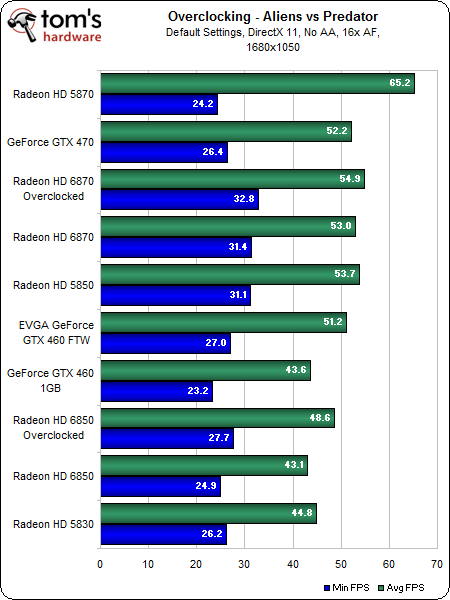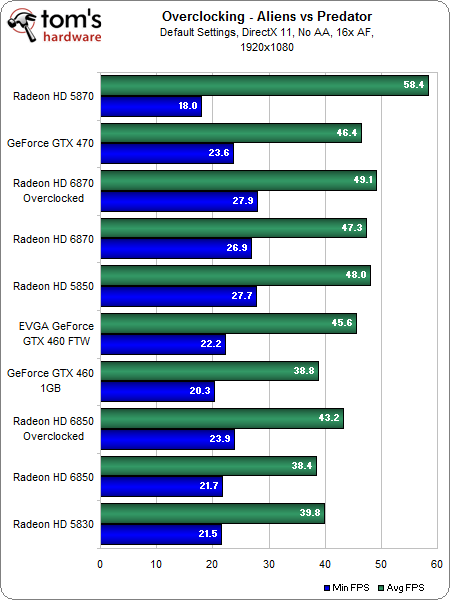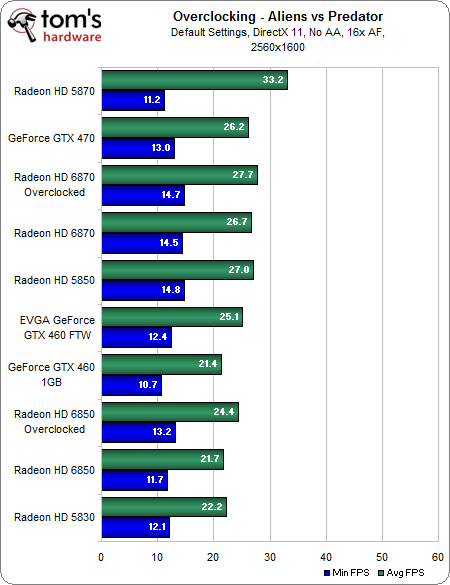AMD Radeon HD 6870 And 6850: Is Barts A Step Forward?
Overclocking Benchmarks
Built on the same 40 nm process as their predecessors, the new Radeon HD 6800-series cards should have similar overclocking headroom as their Radeon HD 5800-series predecessors, and that means 1 GHz is an achievement, even with a voltage increase.
The Radeon HD 6850 turns out to be quite the overclocker, which is not much of a surprise when you consider its stock 775 MHz core clock. This card manages to go all the way to 900 MHz (core), which requires the use of MSI's Afterburner utility. AMD's Overdrive utility caps the Radeon HD 6850 at 850 MHz. The card's memory isn't nearly as accommodating, allowing a mere 50 MHz increase.
On the other hand, the Radeon HD 6870 is a relative overclocking miser, restricting stable running to a mere 50 MHz boost (core). This results in a 950 MHz clock speed, quite close to the 1 GHz ceiling we mentioned earlier. It would be interesting to see what a voltage increase would allow. As for the memory, the card was completely unhappy with anything but the stock 1050 MHz speed.
Note that we've included the EVGA GeForce GTX 460 FTW Edition card in these benchmarks to show what a highly-clocked GeForce GTX 460 1 GB can do. Again, we've allowed the Radeon HD 5870 to strut it's stuff as well.
Aliens vs Predator is an ideal benchmark for an overclocking test because its performance is decidedly GPU-limited. In this test, we see a notable gain from the Radeon HD 6850 overclock, but not much from the Radeon HD 6870's best effort.
The EVGA GeForce GTX 460 FTW edition card gives a very strong performance compared to the regular GeForce GTX 460, suggesting that this is, indeed, an overclocked card to be reckoned with.
The $350+ Radeon HD 5870 walks away with an easy win, showing exactly what 1600 shader cores bring to the game.
Get Tom's Hardware's best news and in-depth reviews, straight to your inbox.
Current page: Overclocking Benchmarks
Prev Page Anti-Aliasing Benchmarks Next Page CrossFire/SLI BenchmarksDon Woligroski was a former senior hardware editor for Tom's Hardware. He has covered a wide range of PC hardware topics, including CPUs, GPUs, system building, and emerging technologies.
-
SteelCity1981 Yeah I agree. I don't get AMD's marketing on the 6000 series. One would think that the 6870 would obv performan better then the 5870 at first glance but instead it yelds less performance then the 5870. That just doesn't make any sense from a consumor standpoint.Reply -
TheRockMonsi I like where AMD is going with the 6000 series, not so much with naming, but pretty much everything else about it. Can't wait for the 6900's, those are going to be beasts!!!!!Reply -
Poisoner I think AMD did a great job with these cards. Its just sick at what performance you can get for 200 bucks.Reply -
duk3 Nice benchmark suite!Reply
I am looking forward to the 6900 series and 22nm gpus later on for some real performance improvements. -
takeapieandrun Not exactly powerhouses, but I do believe they will be great for market competition.Reply -
forces nice but... where is Crysis!!!? they can play Crysis i know but how well can they play it? everyone has Crysis and have played Crysis and will play it... :(, its a nice game to compare perfomance...Reply


